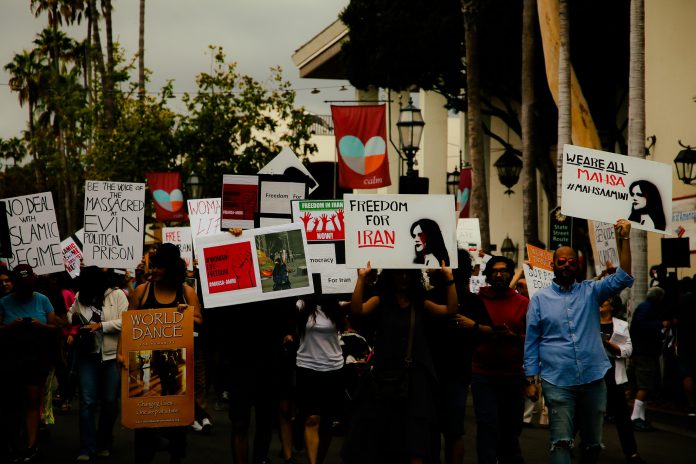Erick Aragon Alvarado
News Editor
Mahsa Amini’s death on Sept. 16 while in the custody of Iran’s notorious “morality police” sparked worldwide protests against the Islamic Regime’s firm grip on its own people. The Bottom Line (TBL) sat down with UC Santa Barbara (UCSB) Professor Aazam Feiz and a few UCSB students to explore the rising tensions against the regime, the implications of the death of Amini and many others, and the goals of the ensuing protests worldwide.
While visiting the capital city of Tehran with her brother, Amini (مَهْسا امينى) was detained for violating the government’s dress code laws. Three days later, after falling into a coma, the Iranian authorities claimed that the 22-year-old died of a heart attack, something her family and the Associated Press dispute.
The morality police have been patrolling the streets of Iran (ee-raw-n) in an official capacity since 2005, but with no clear standards or code of conduct. For Iranian UCSB Professor Feiz, who has experienced Iran’s policies over the last few decades, this is something she can attest to.
“There is no transparency. It is not clear,” Feiz told TBL. “For example, sometimes if you show this much of your head, it is good. But for Mahsa, they say, you have [shown] this much of your head and you have a little makeup — you should not do that. It depends [on] that officer.”
The outrage that ensued after Amini’s death comes after more than 40 years of pent up anger against the policies of the oppressive Islamic Regime of Iran. From 1978-9, the Iranian Revolution took place, and although multiple factions were behind the revolution, especially liberal and intellectual groups, it was the Islamist faction that ultimately took control of the country.
Ever since, the regime has been behind numerous cases of abuse of human rights and atrocities including the persecution of journalists, artists, dissidents, LGBTQ+ people; comprehensive gender discrimination against women and girls; internet blackouts during protests; severe discrimination against religious and ethnic minorities and more.
The government has even been known to kill its own people and use its enemies as scapegoats. Moreover, Iran’s current president Ebrahim Raisi, who, Professor Feiz stressed, has “only six years” total of schooling, is known to have been involved in the killing of thousands of political prisoners in 1988.
UCSB student Aran Hosseini told TBL, “We’ve reached the kind of culmination of decades of these kinds of abuses. It’s no longer protests, I would say. We’re in the midst of a revolution.”
What is happening right now are not anti-hijab protests or protests for economic or governmental reform. Mahsa Amini (Kurdish name Jeena), who was part of the persecuted Sunni Muslim and Kurdish minorities; Nika Shakarami, whose skull was smashed, cheekbone dislocated, teeth broken, and then killed by security forces after participating in the protests; Sarina Esmailzadeh, whose skull was cracked and then killed also by the security forces for the same reason. And many many more. They are representative of a much larger and terribly complex issue of governmental violence and religious imposition.
A Persian American female student at UCSB agreed to discuss with TBL the current situation on condition of anonymity for fear of retribution from the regime.
“It is [about] the right to simply choose between this or this, the right to wake up in the morning and make your own choices. It’s much more than just this idea of a hijab. I think it goes much deeper than that,” she said. “[But] I’ve had many run-ins with [the morality police], and I haven’t been able to go back to Iran as a result of them.”
For decades, the deeply conservative theocratic regime has forced its beliefs upon the people of Iran and has been repeatedly willing to stretch, alter, or otherwise make up what is Islamic doctrine.
Working off of anachronistic mandates from the Quran that afford women half a share of any inheritance as that of a man, in Iran it is taken to a new level, deeming a woman to be holistically worth half of a man. A woman also cannot travel freely without the consent of her male guardian, women are not given priority in child custody battles, they cannot serve in high offices, they are barred from certain subjects in academia, and much more.
“Nowhere in the Quran does it say that you need to cover yourself from head to toe and that women are shit or anything,” the anonymous Persian American female told TBL.
A second Persian American female student spoke with TBL, also on the condition of anonymity for fear of endangering her family in Iran. She lamented how “the country has been portrayed [negatively] by the news in past decades, when in reality the people are so wholesome. It’s really a great place. There’s so much history — so much good history.”
“Now it is the time to differentiate between the normal people of Iran and the regime of Iran,” said Professor Feiz. “[Since 1979,] the people of Iran have been occupied by an Islamic terrorist regime.”
Now, after feeling they have exhausted every possible path to reform, the people of Iran feel there is no other alternative than to get rid of the current regime. “[T]he breadth of Iranians’ grievances,” as a New York Times article put it, can be seen in the unprecedented diversity of the protesters. But it is also a testament to the danger that cruelty in one place represents to the world at large.











